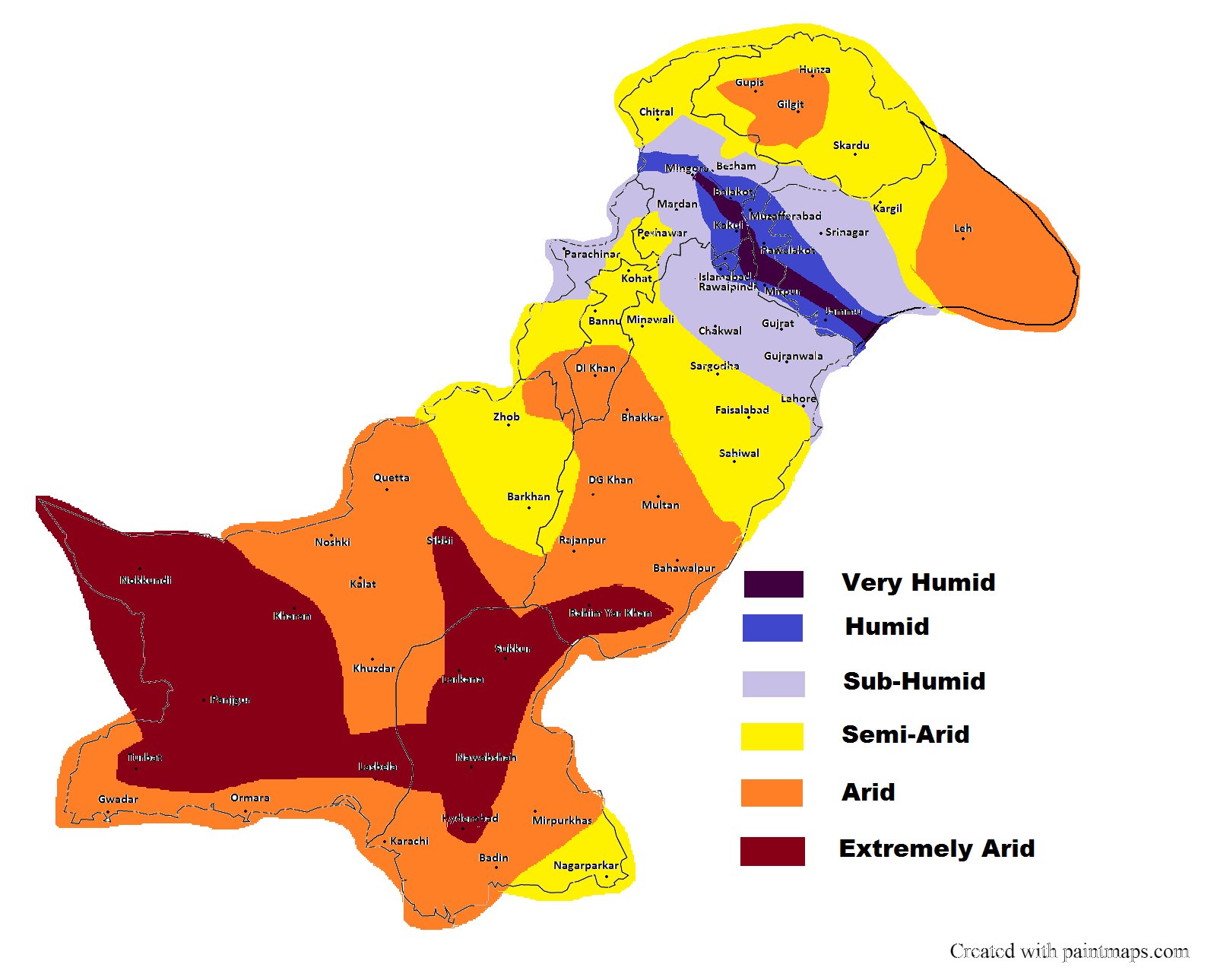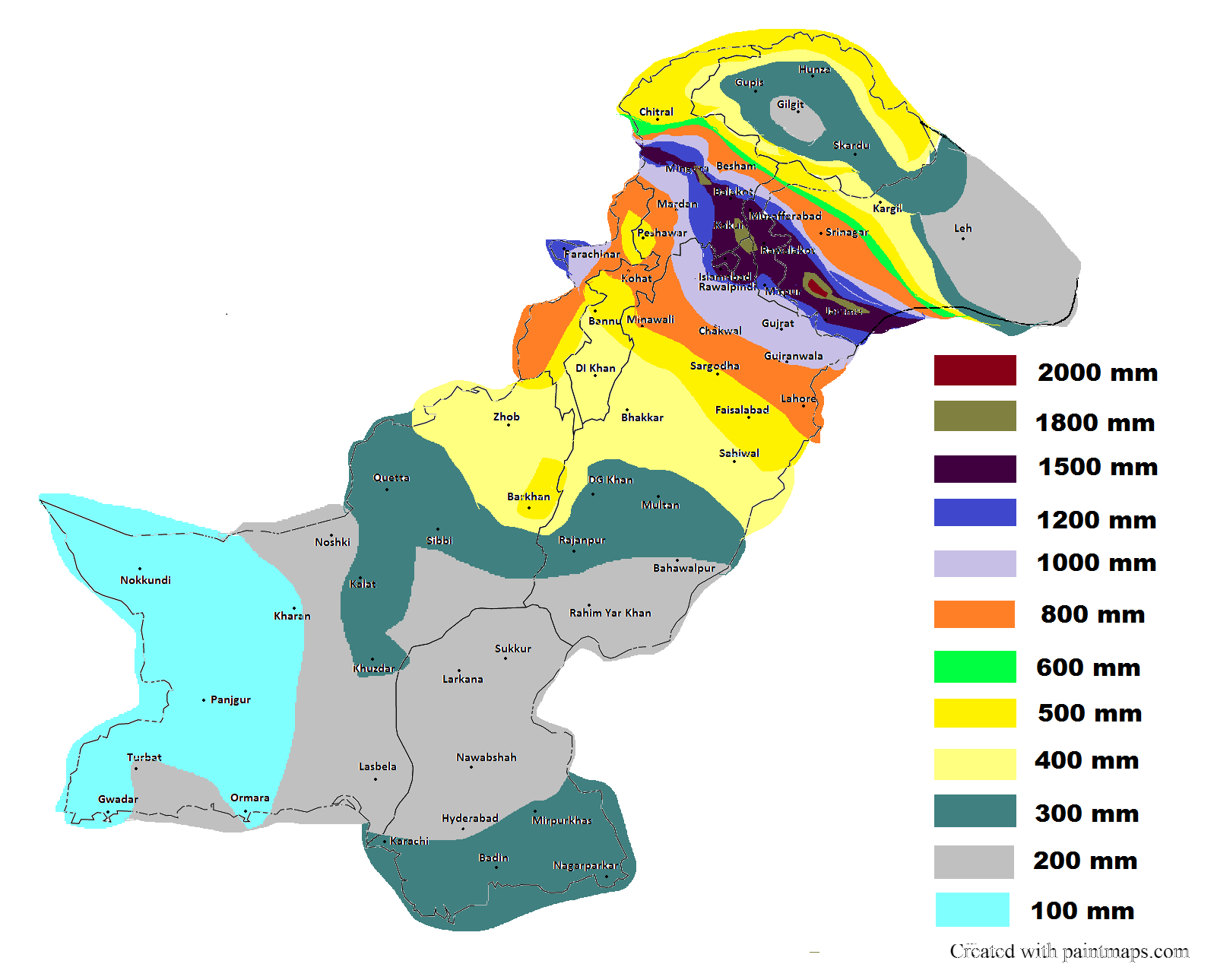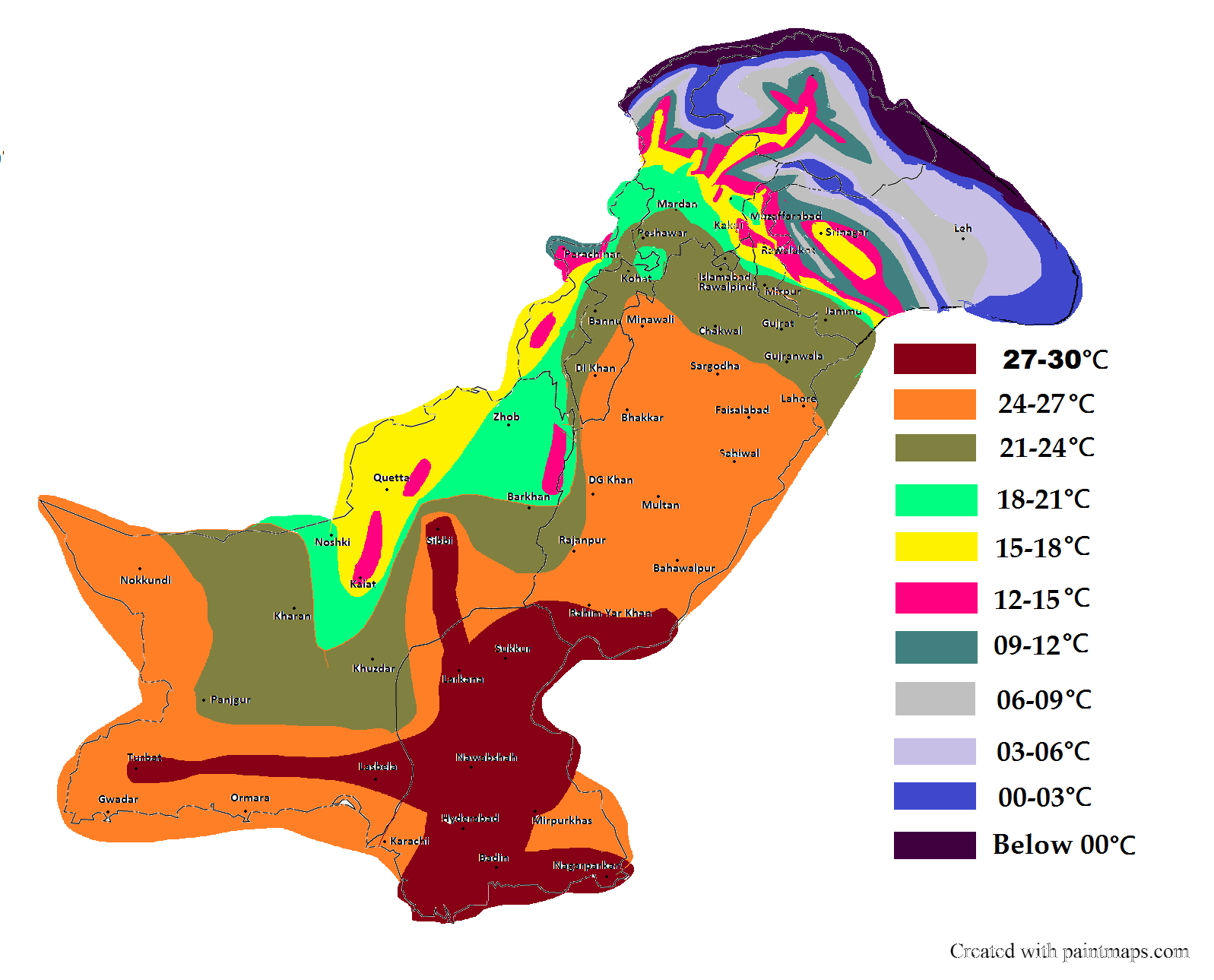Pakistan is a large country with an area of 881,913 square kilometers, the 33rd largest in the World. From north to south, it is located between latitudes 23 and 37 degrees north. Due to its large area and great north-to-south length, Pakistan is home to a diverse climate. Pakistan is home to sandy beaches in the south, and desert and plains areas in the central and greater Himalayan mountains towards the north. Each of these areas has a unique climate to talk about.
Seasons in Pakistan
Pakistan experiences all four plus one seasons. The winter season starts in late November and ends in February. The spring season begins in late February and ends in March or early April, depending on where you live. The summer season starts in mid-April and lasts until September. October till mid-November is generally the Autumn months. There is one more important season the Rainy season or southwest monsoon season which generally starts late June and lasts till 3rd week of September.
Factors Affecting the Climate of Pakistan
Several factors affect the climate of Pakistan during the year. Some of the factors are briefly described below:
Western Disturbances
Western disturbances are extratropical storms formed in the Mediterranean Sea/Atlantic Ocean and travel several thousand Kilometers before reaching Pakistan. These WDs mostly affect Pakistan during the winter season, though, they keep coming in other times of the year with lesser frequency and intensity. WDs mostly result in light to moderate rains and heavy snow over the northern mountains.
Southwest Monsoon
Southwest monsoons affect most parts of Pakistan during the summer season starting as early as Mid June till September. They are formed due to a low-pressure area that formed over the Thar desert during the hot summer months that pull the moist winds from the Indian Ocean. They are responsible for heavy rains and regulation of temperature during the summer months.
Fog/Smog
Fog/Smog is one of the most prominent factors that influence the climate of Pakistan during the Autumn and winter seasons. The smog is formed due to a mixture of fog and smog produced due to the burning of Kharif crops due to very stable atmospheric conditions. Fog reduces the duration of sunlight and causes cold days weather conditions in plain areas of the country.
Heat and Cold Waves
As the name depicts, heat waves are periods of unusually high temperature for at least 05 consecutive days. They are common during peak summer months of May, June, and July in plain areas. The temperature during hot waves can reach as high as 50 C in many parts of the country.
Cold waves on the other hand are 05 consecutive days of lower-than-normal temperatures. The peak time of cold waves is during December/January when the minimum temperature can plummet to below freezing point in the north while near freezing in central and southern regions.
Drought/Floods
Droughts and floods are integral parts of the climate of Pakistan. Droughts are more common in Balochistan and Thar deserts of Sindh. They are caused by very low precipitation and above-average hot weather for a prolonged duration in summer.
Heavy monsoon rains during summer months cause floods, coupled with high glacial snow melt. Heavy rain in the north and glacial melt water combined to form floods in plain areas of the country. The most recent years when flooding occurred include 2010, 2011, and 2022.
Climate Classification of Pakistan
Pakistan is a vast country with a North-South length of more than 1500 km. Therefore, it is home to a variety of climatic zones. Generally, as you move from south to north, the climate starts to get wetter and cooler. Pakistan can be divided into six climatic zones when classified by moisture availability index. A brief description of these regions is provided below:

Extremely Arid Climatic Zone
This type of climate exists in southern parts of Pakistan, particularly Central Sindh, Southwestern Balochistan, and extreme southern Punjab. On average, these areas have very little annual rain and face extremely hot weather during the long summer. The winter season is small and mild. The average rain here is around 100 mm per year with temperatures exceeding 50C is not uncommon. The major cities of Pakistan in this climatic zone include Hyderabad, Sukkur, Larkana, Rahim Yar Khan, and Turbat.
Arid Climatic Zone
This type of climate is prominent in Southern Punjab, most of Sindh, Western, Southern, Central Balochistan, and southern KPK. These areas receive little amount of precipitation with hot summer and cool winter. Mean Annual rainfall here ranges between 100 mm to 300 mm. Temperatures during summer can reach as high as 50C and in winter it can touch as low as 5C. Central Gigilt Batlistan and most of Ladakh also fall in the Arid Zone, however, the winter season is very harsh while summer is pleasant to moderately hot in most parts. Temperature can fall as low as -30C in winter in remote areas of Gilgit Baltistan and Ladakh region. Multan, Quetta, and Karachi are part of this climatic zone.
Semi-Arid Climatic Zone
This type of climate is prominent in Central Punjab, Southeastern Sindh, Northeastern Balochistan, central, and extreme north KPK, most of Gilgit Baltistan, and some parts of the Ladakh region. These areas receive moderate amounts of precipitation/rain with hot summer and cold winter. Mean Annual rainfall here ranges between 300 mm to 700 mm. This amount of rain is more than in arid regions but still insufficient to cater to the hot summer temperatures. Temperatures during summer can reach as high as 45C and in winter it can touch as low as 0C. While Gigilt Batlistan parts of Ladakh that fall under this climatic zone face severe winter and mild summer. Temperature can fall as low as -40C in winter in remote areas of Gilgit Baltistan and Ladakh region. Lahore, Faisalabad, Sargodha, and Peshawar are parts of this climatic zone.
Sub-Humid Climatic Zone
This type of climate is prominent in upper Punjab, north KPK, and lower and upper Kashmir. These areas receive significant amounts of rainfall with very warm summers and cold winters. Mean Annual rainfall here ranges between 700 mm to 1000 mm and falls in both seasons. Temperatures during summer are high but not as harsh as in arid and semi-arid regions. Winter is cold and snow is common in high mountainous regions. Rawalpindi, Sialkot, Gujranwala, Srinagar, Mardan, and Parachinar are parts of this climatic zone.
Humid & Very Humid Climatic Zone
This type of climate is prominent in extreme north Punjab, northeastern KPK, and central Kashmir. These areas receive abundant amounts of rainfall with warm summers and cold winters. Mean Annual rainfall here ranges between 1000 to 2000 mm and falls year round with one peak during the spring season and a second during the monsoon season. Temperatures during summer are high but not as harsh as in arid and semi-arid regions. Winter is cold and snow is common in high mountainous regions. Islamabad, Murree, Abbotabad, Muzzafarabad, Mingora, Jammu, and Dir are parts of this climatic zone.
Precipitation Map of Pakistan
Being a vast country, Pakistan is home to a diverse climate. The amount of mean annual rain generally increases from south to north. See the map below:

As the map depicts, precipitation is generally very low towards the south and extreme north and increases may fold towards the foothills of the Himalayas.
Driest Areas
The driest portion of Pakistan receives less than 100 mm of annual rain and is located on the western side of Balochistan bordering Iran. Similarly mean annual precipitation is extremely low in Ladakh and central Gilgit Baltistan region. The reason for such low precipitation are rain shadow effect as monsoons can not penetrate these areas. Nokkundi, Panjgur, Gwadar, and Leh are part of this region.
Other arid regions of Pakistan where mean annual rain is very little in the range of 100-300 are located in Southern Punjab, most of Sindh, Central Balochistan, and the extreme northern regions. These areas consist of fertile land and deserts. The lower Indus plain beyond Panjnand and deserts like Thar are part of the region. Most parts of Gilgit Baltistan and Ladakh valleys also receive up to 300 mm of annual rain. Major cities including Karachi, Hyderabad, Multan, Quetta, and Gilgit receive rain in these ranges.
Slightly Wet Areas
These areas receive a moderate amount of mean annual rain in the category of 300 to 700 mm. Such areas are mostly located in central areas of Pakistan. The region mainly includes fertile land of central Punjab, central KPK, Northeastern Balochistan, and some parts of high Gilgit Baltistan. Here the rain is just enough to not categorise it as an arid region. These areas are rich in agriculture, however, it mostly depends on canal systems or tube wells. The major cities located in slightly wet areas include Faisalabad, Peshawar, Sargodha, Dera Ismail Khan, Sahiwal, and Zhob.
Moderately Wet Areas
These areas receive a moderate to heavy amount of mean annual rain in the category of 700 to 1200mm. Such areas are mostly located in the Upper half of Pakistan. The region mainly includes north Punjab, north KPK, and most parts of Kashmir valley. Here the rain is heavy enough to sustain the moisture for the growth of crops and thin forests. Plain areas of Punjab located in this zone are home to rice crops. On the western Punjab side of the Potohar region, crops are heavily dependent on the timely arrival of rain. The northern KPK side is home to tourist places some forests are also found there. Most of Kashmir valley receives less than 1200 mm of rain annually. The cities located in this region include Rawalpindi, Lahore, Gujranwala, Srinagar, Mingora, Kotli, Mardan, Kalam, Naran, Parachinar, and Kohat.
Wet-High Rain Areas
These areas receive heavy amounts of annual rain. These wet areas are mostly located in the foothills of the Himalayas and Hindukush mountains. Mean annual precipitation here ranges from 1200 mm to more than 2000 mm in some parts. Most of central Kashmir, northeast KPK, and extreme north Punjab are located in this zone. The reason for the heavy rain in this region are high Himalayan mountains that stop the moist winds coming from the south during monsoon and from WDs in winter. These regions are home to very thick forest cover and humid climates. Cities located in this zone include Islamabad, Abbottabad, Muzaffarabad, Jammu, Murree, Gulmarg, Malam Jabba, Balakot, Shogran, and Upper Dir.
Temperature Map of Pakistan
The mean annual temperature in Pakistan generally decreases as we move from south to north and east to west. There are hot desert areas to the south and high mountains to the north which cools the temperatures. See the map below for understanding:

Summer Season
Summer in Pakistan lasts from April to September. Plain areas of Pakistan are known for very high temperatures during the summer. Sometimes, the temperature can exceed the 50C mark during the peak summer months of May, June, and July. The world’s fourth hottest temperature of 53.7 C was recorded in Turbat, Balochistan on 28th May 2017. Similarly, other cities and towns such as Sibbi, Jacobabad, and Multan are world-famous for being very hot during the summer months.
However, the temperatures towards the northern areas of Pakistan stay cool during peak months thanks to high elevation. Tourist places like Swat, Murree, Naran, and Neelum Valleys enjoy cool temperatures between 15 to 25 C during the summer months, making them perfect escape points for tourists to avoid scorching temperatures.
Winter Season
Winter season in Pakistan is relatively short starting in late November and ending in February. Winter season is moderate in the south and harsh towards the north. In the coastal regions of the country, temperature stays comfortable during the winter and seldom decreases below 10C. Meanwhile in the plain areas of the country temperature can drop to 5C or less during peak winter months of December-January.
However, in north Pakistan including upper KPK, Kashmir, Gilgit Baltistan, Ladakh, and northeast Balochistan winter is very harsh and snow is common during this time. Places like Skardu, Hunza, Kalam, Naran, Nathiagali, Malam Jabba, Neelum, Gulmarg, Ziarat, and Muree can receive several feet of snow during the winter season. The temperature here can drop below -10C.
